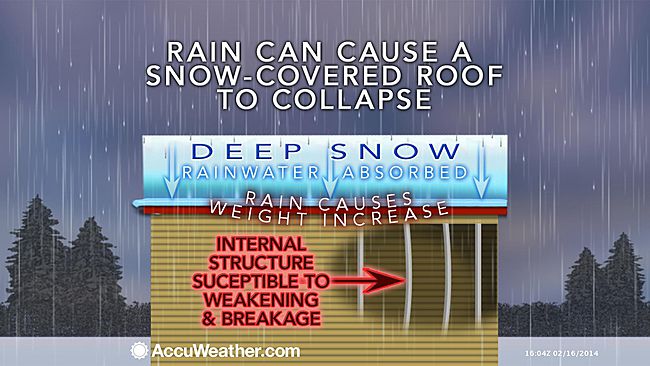Report: More roof collapses possible with upcoming warm-up, rain

An AccuWeather.com graphic depicting why roofs collapse when added liquid.
Dozens of roofs have collapsed throughout the region since last week due to the significant weight of accumulated snow.
Ranging from small sheds to a supermarket, the elevated snowpack is wreaking havoc by compromising the structural integrity of buildings.
Chuck Anania, a Montclair roofer, told The Star-Ledger that most roofs, and in particular flat, commercial roofs, are not designed to carry the snow and liquid that remain on buildings. With recent sub-freezing temperatures, the pack is becoming heavier, Anania said.
Just two feet of snow on a typical roof can be the equivalent of 19 tons, according to homesessive.com.
And with additional snow on the way for Tuesday morning followed by a brief thaw and rain, more roofs are in danger of collapsing, AccuWeather.com Meteorologist Jim Andrews warned in an AccuWeather.com article.
“The snow will soak up the rain that falls later this week like a sponge, leading to added weight and stress on structures,” Andrews said.
Here is important information from the insurance provider State Farm:
Understand the Dangers
Heavy loads of ice and snow can create serious problems for your home. These include:
Injuries from snow and ice falling from sloped roofs.
Roof collapse, especially on flat roofs.
Carbon monoxide poisoning resulting from blocked chimneys and vents.
Water damage from ice dams that form on the edges of roofs and in gutters.
Watch for Warning Signs
Recognize the signs of stress when too much snow and ice has accumulated on your roof:
Sagging ridgeline.
Drooping ceilings.
Water leaks on interior walls and ceilings.
Jammed doors.
Cracked interior walls near the center of your home.
Creaking sounds.
Avoid Excessive Buildup
Removing ice and snow from your roof is a dangerous job. Avoid injury by hiring a professional to fix the problem before it leads to property damage and expensive repairs. Here are some ways to prepare your home:
Purchase a roof rake to help pull excess snow off the roof.
Avoid using salt or chemical snow-melt products to melt ice on the roof. These can erode shingles and gutters and potentially void the roofing manufacturer’s warranty.
Add insulation to your attic to help prevent your home’s warm air from escaping into unheated attic spaces. Ice dams form when warmed attic air melts a layer of snow on the roof. This melting snow slides down the roof and refreezes on unheated overhangs and gutters. Do not attempt to “chip away” the ice formed by an ice dam as that may lead to shingle damage.
If replacing your home’s roof, have a self-sealing membrane installed under the shingles to help prevent water damage from ice dams.
On metal roofs, install snow guards above entrances.
WHYY is your source for fact-based, in-depth journalism and information. As a nonprofit organization, we rely on financial support from readers like you. Please give today.

